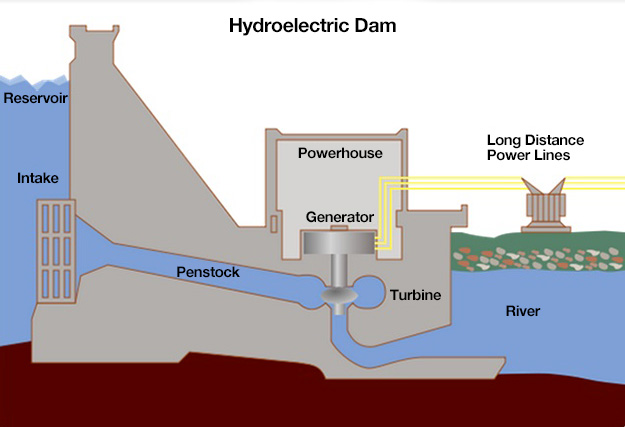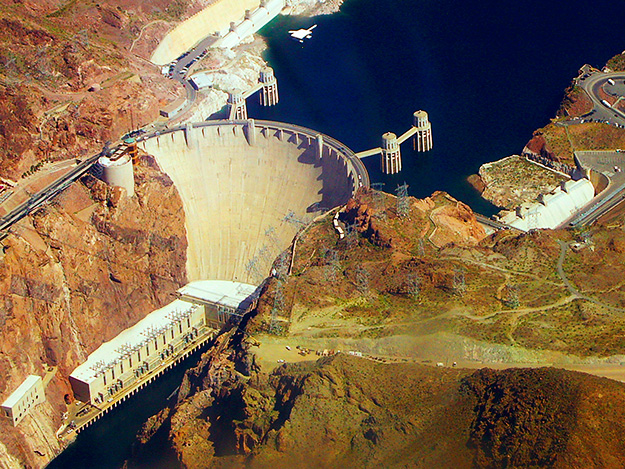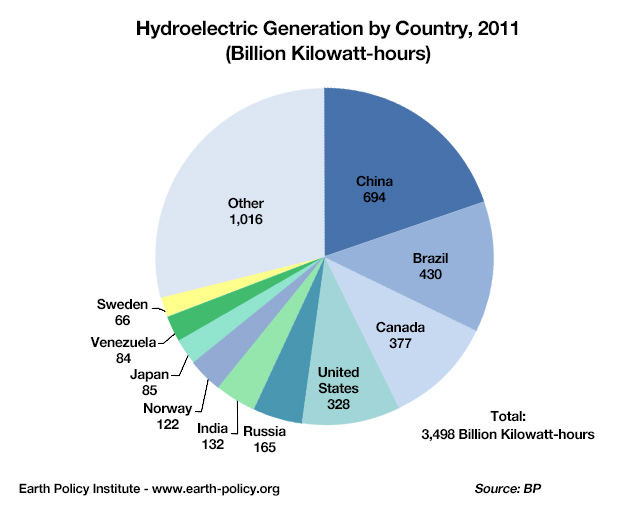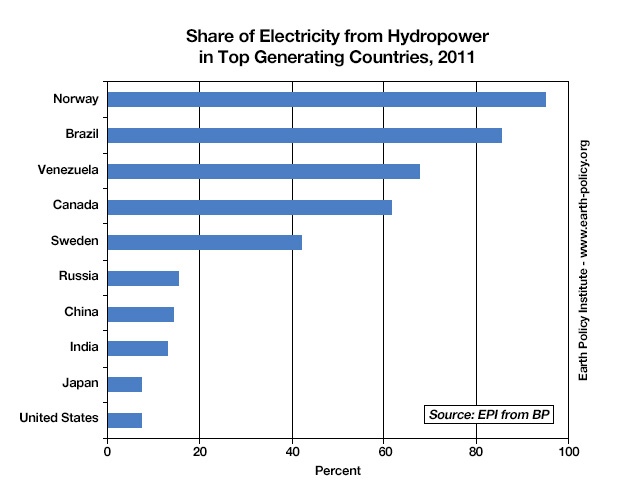Hydroelectricity (Waves & Tides)
Hydroelectricity - Dams, Waves, & Tides
Fossil fuels dominate the electricity generation mix of the US as a whole and the global energy mix more generally. But in some areas of the US (like the Pacific Northwest) and in some countries, including several in South America and Europe, the 800-pound gorilla of electric power generation isn’t coal, oil or even natural gas – it’s hydropower, generated from immense dams placed along the world’s major rivers. In both the US and globally, hydropower is the largest renewable resource in the energy mix, and certainly the largest source of renewably generated electricity. While growth in the use of hydroelectricity (at least the traditional type – generated by very large dams) has slowed to near zero in the U.S., many other countries in both the developed and developing world are pushing ahead with major projects to dam rivers and generate immense amounts of electricity.
This is a good thing, right? After all, the more power that is generated from hydroelectricity, the less that we might have to generate using fossil fuels, and the fewer greenhouse gases that the global energy sector will release. While it is certainly true that there are no direct greenhouse-gas emissions from hydroelectricity, broadening the use of hydropower, particularly in heavily forested areas of the world, introduces other complex environmental and social impacts. In fact, the reservoirs behind dams are major sources of methane (a potent greenhouse gas), so hydro is not exactly a carbon-free source of energy.
In this section, we’ll take a look at the processes for harnessing water for electric power generation – and these processes are not limited to damming rivers (though dams are certainly the predominant method for harnessing water energy). Like wind energy, humans have been using water for “energy” purposes (i.e., to do useful work) for thousands of years, making river systems one of the world’s oldest energy resources. For the first couple of thousand years of hydro-energy’s existence, the energy in flowing water was used to turn water wheels not for power generation, but for grinding or milling things like wheat, to make flour. It was not until the 1880s that hydroelectricity was born, with small hydropower dams in Michigan and Niagara Falls providing electricity to those places.
How do we turn water into electricity?
There are three basic technologies for using flowing water to generate electricity:
- Hydroelectric dams generate power by allowing water from behind the dam (from a reservoir or impoundment) to flow through a turbine. The turbine spins, generating electricity. This is not unlike a steam turbine (which utilizes coal, gas or oil as a fuel) or wind energy (which utilizes the wind as a fuel to get the turbine to spin).
- Wave and tidal energy projects use the kinetic energy in ocean waters, again to get a turbine to spin, producing electricity.
- In-stream hydro-kinetics is an emerging set of technologies that are similar in design to wave and tidal energy projects but are meant to be placed in streams.
Conventional Hydroelectric Dams
Conventional Hydroelectric Dams
There are three main types of conventional hydropower technologies: impoundment (dam), diversion, and pumped storage.
Impoundment is the most common type of hydroelectric power plant. An impoundment facility, typically a large hydropower system, uses a dam to store river water in a reservoir. Water released from the reservoir flows through a turbine, spinning it, which in turn activates a generator to produce electricity. Generation may be used fairly flexibly to meet baseload as well as peak load demands. The water may also be released either to meet changing electricity needs or to maintain a constant reservoir level. The layout of a typical impoundment hydropower facility is shown below in the first figure. One of the world’s most famous impoundment dams, the Hoover Dam, is shown in the second figure (although it’s worth noting that on a global scale, the Hoover Dam is more famous than it is large).


A diversion, sometimes called run-of-river, facility channels a portion of a river through a canal or penstock. It may not require the use of a dam but also has limited flexibility to follow peak variation in power demand. Thus, it will mainly be useful for baseload capacity. This scenario results in limited flooding and changes to river flow. In the United States, many of the dams in the Pacific Northwest (on the Columbia and Snake Rivers) are diversion or run-of-river dams, with limited or no storage reservoir behind the dam. The figure below shows a picture of a diversion hydropower facility. Compare what that facility looks like with the picture of Hoover Dam, the impoundment facility shown above.

A “pumped storage” hydro dam combines a small storage reservoir with a system for cycling water back into the reservoir after it has been released through the turbine, thus “re-using” the same water to generate electricity at a later time. When the demand for electricity is low (typically at night), a pumped storage facility stores energy by pumping water from a lower reservoir to an upper reservoir. During periods of high electrical demand (typically during the day), the water is released back to the lower reservoir to generate electricity. The figure below shows a schematic of a pumped storage hydro facility. Pumped storage facilities are typically smaller in terms of generation capacity than their impoundment or diversion counterparts, but are sometimes combined with impoundment or diversion facilities to increase peak power output or flexibility.

Wave and Tidal Energy
Wave and Tidal Energy
Water in the oceans is constantly in motion due to waves and tides, and energy can be harvested from these kinds of motions. Waves, driven by the winds, make the water oscillate in roughly circular orbits extending to a depth of one half of the wavelength of the wave (distance between peaks). Tides, related to the gravitational pull of the Moon and Sun on the oceans, are like very long-wavelength waves that can produce very strong currents in some coastal areas due to the geometry of the shoreline. In terms of power generation technologies, wave and tidal power have both similarities and differences. Both refer to the extraction of kinetic energy from the ocean to generate electricity (again, by spinning a turbine just as hydroelectric dams or wind farms do), but the locations of each and the mechanisms that they use for generating power are slightly different.
Wave energy projects extract energy from waves on the surface of the water, or from wave motion a bit deeper (a few 10s of meters) in the ocean. Surface wave energy technologies capture the kinetic energy in breaking waves – these provide periodic impulses that spin a turbine. The US Department of Energy [7] has a nice description of different types of surface wave projects as follows:
- Oscillating Water Columns: Oscillating water columns consist of a partially submerged concrete or steel structure that has an opening to the sea below the waterline. It encloses a column of air above a column of water. As waves enter the air column, they cause the water column to rise and fall. This alternately compresses and depressurizes the air column. As the wave retreats, the air is drawn back through the turbine as a result of the reduced air pressure on the ocean side of the turbine.
- Tapchans: Tapchans, or tapered channel systems, consist of a tapered channel that feeds into a reservoir constructed on cliffs above sea level. The narrowing of the channel causes the waves to increase in height as they move toward the cliff face. The waves spill over the walls of the channel into the reservoir, and the stored water is then fed through a turbine.
- Pendular Devices: Pendular wave-power devices consist of a rectangular box that is open to the sea at one end. A flap is hinged over the opening, and the action of the waves causes the flap to swing back and forth. The motion powers a hydraulic pump and a generator.
Offshore wave energy systems are typically placed deeper in the ocean, though not too deep – perhaps a few hundred feet below the ocean’s surface. The periodic wave activity at this depth is typically used to power a pump that feeds into a turbine, generating electricity.
Tidal energy projects typically work by forcing water through a turbine or a “tidal fence” that looks like a set of subway turnstiles. The systems depend on regular tidal activity to generate power. Because this tidal activity is predictable (each coast sees at least one tidal cycle per day – high tide and low tide – and some areas actually see two tidal cycles on a daily basis), tidal energy projects have the advantage of being able to provide a fairly predictable source of electricity. The use of tidal power, globally, has been quite limited because there are only a few sites in the world that see sufficiently large variations in tides to produce enough power, as shown in the table below.
| Country | Site | Tidal Range (m) |
|---|---|---|
| Canada | Bay of Fundy | 16.2 |
| England | Severn Estuary | 14.5 |
| France | Port of Granville | 14.7 |
| France | La Rance | 13.5 |
| Argentina | Puerto Rio Gallegos | 13.3 |
| Russia | Bay of Mezen | 10.0 |
| Russia | Penzhinskaya Guba | 13.4 |
| U.S. (Alaska) | Turnagain Arm | 9.2 |
| U.S. (Alaska) | Cook Inlet | 7.6 |
In-River Hydro-kinetics
In-River Hydro-kinetics
When rivers are utilized to produce electricity, that is usually accomplished by building some sort of hydroelectric dam, like the three we discussed earlier. It doesn’t have to be that way, however. Many of the technologies used to extract energy from the tides (or similar technologies) could be deployed in freshwater river systems rather than the saltwater ocean, effectively acting as very small run-of-river facilities. These “hydrokinetic” power generation systems are typically individually small (each generating about 100 kilowatts or less of power) and could be situated in two ways. First, a propeller-like or turnstile-like turbine could be deployed directly into the riverway, operating much like a small-scale tidal power system. Second, a “micro-hydro” type of system could be employed, where river water is channeled to a turbine housing via a channel or pipeline, as shown in the figure below.

Global Use of Hydroelectricity
Global Use of Hydroelectricity
Globally, hydroelectricity is a major electricity resource, accounting for more than 16% of all electricity produced on the planet. More electricity is produced globally using hydropower than from plants fueled by nuclear fission or petroleum (natural gas and coal do produce more electricity globally than hydropower does). More than 150 countries produce some hydroelectricity, although around 50% of all hydropower is produced by just four countries: China, Brazil, Canada, and the United States. China is by far the largest hydropower producer on the planet, as shown in the figure below. Hydroelectricity production in China has tripled over the past decade, with the completion of some of the world’s largest dam projects, in particular, the Three Gorges Dam (the world’s largest), which could produce nearly enough electricity to power all of New England during a typical summer and left an area roughly the size of San Francisco flooded underwater.

Once hydroelectric dams are built, they run very cheaply and generally provide reliable supplies of electricity except during times of extreme drought. Developed countries that have substantial hydro resources have, by and large, already utilized those resources to produce electricity. In these countries, hydropower dominates the electricity supply system as shown in the chart below. Norway leads the pack here – the amount of hydropower that it produces is not large in an absolute sense (it is the world’s seventh-largest producer) but nearly all electricity generated in Norway comes from hydro-power. Brazil and Canada are also highly dependent on hydropower. Other large hydro producers, such as China and the United States, produce much less hydroelectricity relative to the size of their overall power sectors.

Hydroelectric Potential
Hydroelectric Potential
It is often said that developed countries like the United States have little potential for growth in hydroelectric power generation – the US, in particular, has dammed so many rivers, that what could possibly be left? In some areas of the Pacific Northwest, the US is removing some dams that produce electricity due to environmental concerns. It is certainly the case that there is relatively little potential for new hydro mega-projects in the US. This does not mean, however, that there is nowhere left to build new hydroelectric projects. There are, in fact, several hundred megawatts of planned hydroelectric generation in the Mid-Atlantic US alone (see the map at PJM [9]) [10], though most of the projects would be small pumped storage facilities) We’ll walk briefly through a few examples of the hydro resource potential in the United States before taking a more global look.
First, not all dams in the US are equipped with turbines to generate electricity. There are, actually, quite a few that aren’t (see the interactive map at Energy.gov [11] – potentially enough power generation to supply more than ten million homes. Many of these are located along major shipping routes, like the Ohio and Mississippi Rivers. Others are located in areas where development might not make economic sense because the power would need to be shipped across large and expensive transmission lines. Another unconventional technology – hydro-kinetics – could potentially supply enough electricity to power the state of Virginia, although these resources are highly concentrated in the Lower Mississippi River and in more remote areas such as Alaska.
Globally, the picture is very different. Developing nations with abundant hydro resources, like China, Brazil, and other South American countries, are rushing headlong into planning and building new dams. So globally, hydroelectricity is alive and well, and growing rapidly (no pun intended) – although this growth comes in fits and starts since new dams each represent a big chunk of capacity and take a long time from project start to finish. Nearly half of the world’s fifteen largest dams were built since the year 2000, with only one of those in a country other than China or Brazil (the Sayano Shuskenskaya dam in Russia was recently upgraded, although the original went into place in the 1980s).
Energy from hydropower has been growing at a steady annual rate of 0.3 EJ per year since the year 2000, faster than the previous decades, but overall, hydro still accounts for just 16 EJ of the total 580 EJ we used in 2018. Some estimates suggest that if we really developed all of the economically viable hydroelectric sites, we might be able to generate as much as 50 EJ of hydroelectric energy — still a far cry from the +600 we will need in the near future. But even though hydro cannot solve all of our energy problems, it is nevertheless very important in that it supplies a relatively low-emissions, dispatchable (on-demand) energy source that can help smooth out the variability in wind and solar energy production.
Challenges to Further Hydroelectric Deployment
Challenges to Further Hydroelectric Deployment
While hydro development is still growing in several regions of the world, many countries, including the United States, will not likely pursue larger hydro projects due to two main factors — first, we have already built hydroelectric dams in most of the best places, and secondly, there are concerns over the environmental and societal impacts of building more dams. These environmental impacts have even been used to justify dam removal in some cases, though weighing those environmental impacts against the societal benefits (such as irrigation, flood control, recreation, and so forth…not just electricity) has always been controversial. Some of these specific environmental and societal impacts include:
- Impacts on fish migration – fish migrating up or downstream may find passages blocked by dams or may get killed going through turbines.
- Reduced water quality – changes in natural stream-flow may, in some cases, muddy waters. This affects the river ecosystems that aquatic plants and animals utilize.
- Land inundation – reservoirs behind dams can flood large areas. There is not necessarily a relationship between the size of the dam and the amount of area flooded behind the dam. Two impacts can arise here. First, building large hydro projects often involves the displacement of many people who used to live in the area surrounding the river. The Three Gorges Dam in China involved the relocation of more than one million people.
- Methane release to the atmosphere — plant life can decay in flooded areas, which over time releases large quantities of methane into the atmosphere – enough that it can potentially offset the avoided CO2 emissions from many years worth of fossil fuel use. A recent estimate places the global emissions of methane high enough to make hydropower be just a little bit less than natural gas in terms of CO2 (equivalent) per unit of energy generated.